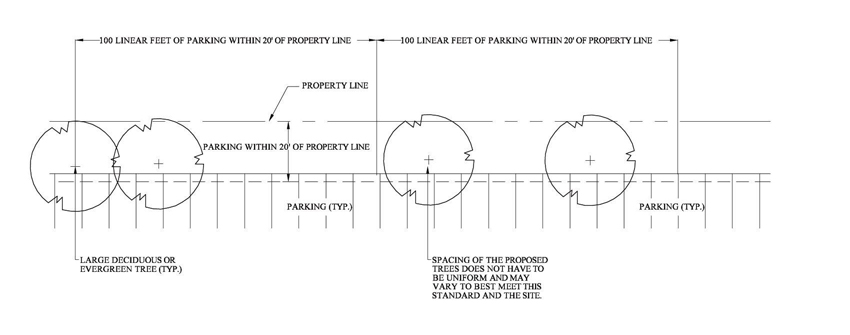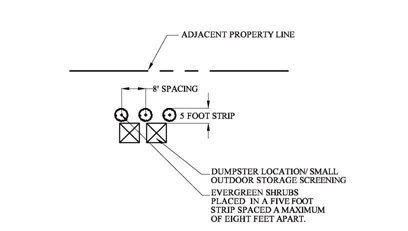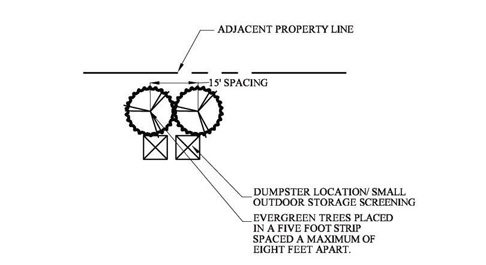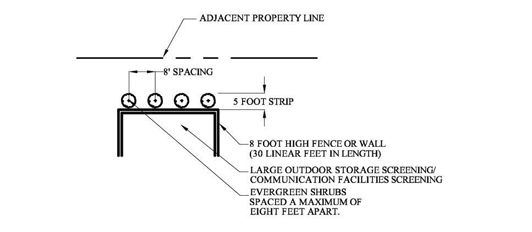ARTICLE V. LANDSCAPE DESIGN STANDARDS
The requirements set forth in this Article shall be complied with in addition to any other general or specific requirements of this Chapter. The regulations of this Article apply to: (1) the establishment and operation of a new use; (2) the entire property where any expansion of floor area/paved surface equals or exceeds 50 percent of the pre- expansion area; and (3) those portions of property which extend around and are parallel to the expansion of floor area/paved surface where the expansion area is less than 50 percent of the pre-expansion area. These requirements in no way relieve a use of having to meet all local, state and federal laws pertaining to the establishment and operation of that use.
42-166. General
The landscaping standards of this subpart provide requirements for all buffering. This section provides standards for each buffer type. The following standards shall be in effect to provide an appropriate transition between uses, and compliance therewith is required for the establishment and operation of a new use.
42-167. Buffer Determination
Buffers will be determined by identifying the zoning districts of adjacent land use(s). Table 5.1 outlines buffers required between zones. Where the property shares a boundary with more than one (1) zone, the width of the most intense buffer shall be required along the perimeter of the area to be developed; however, the plant materials required shall be calculated and placed based on the respective applicable buffer. See §42-168 (Plant Material) for required plant material.
| Table 5.1 Buffer Requirements | |||
|---|---|---|---|
| Zoning District | Industrial | Commercial | Residential |
| Industrial | N/A | B1 | B2 |
| Commercial | B1 | N/A | B1 |
| Residential | B2 | B1 | N/A |
42-168. Plant Material
Table 5.2 describes the width and plant material requirements for the buffers identified in Table 5.1. The length of the perimeter of the area to be developed shall be used in determining the number of plants required.
| Table 5.2 Buffer Width And Plant Material Requirements | |||||||
|---|---|---|---|---|---|---|---|
| Buffer Type | Width (FT) | Plant Material Required Per 100 Linear Feet | |||||
| Deciduous Trees | Evergreen Trees | ||||||
| Large | Small | Large | Small | ||||
| B1 | 20 | 1 | 2 | 2 | 6 | ||
| B2 | 30 | 2 | 3 | 5 | 12 | ||
42-169. Plant Material Placement
The placement of buffer plantings shall be at the discretion of the developer, and shall be approved as part of the site plan submitted. Trees or shrubs shall not be planted within five (5) feet of any property line to ensure maintenance for access and to avoid encroaching onto the adjacent property. Where a setback requirement is less than the buffer requirement, the buffer width shall override the setback width. Where a setback requirement is greater than the buffer requirement, plant material requirements shall still be applied and such plant materials shall be placed within the buffer area. Trees and shrubs shall be spaced to provide screening.
42-170. General
The landscaping standards of this subpart provide requirements for all parking lots consisting of ten (10) or more spaces. The following standards shall be in effect for each parking lot of this size, and compliance therewith is required for the establishment of a new or expansion of an existing parking lot.
42-171. Plant Material Placement
For every five (5) parking spaces one (1) small or large deciduous tree shall be required. Plant material shall be placed within the parking lot or within 20 feet of the perimeter of the parking lot. All parking spaces shall be within 60 feet of a tree, as measured from the tree trunk to any portion of a parking space.
42-172. Planting Strip
When no buffer is required along front, side, and rear property lines of a development and parking is proposed within 20 feet of said property lines, a planting strip is required. The planting strip shall be a minimum of ten (10) feet in width and shall contain two (2) small or large deciduous or evergreen trees per 100 linear feet (see Figure 5A). A planting strip design may include small and large deciduous and evergreen trees and shrubs. For the purpose of a planting strip, six (6) shrubs shall be considered equivalent to one small or large deciduous or evergreen tree.
Figure 5A. Planting Strip
Not to Scale, Dimensions May Vary

42-173. Parking Island
When parking lots contain multiple bays of parking, parking islands shall be installed and one-third (1/3) of the required plant material for the parking lot shall be placed within the islands. A parking island shall be a minimum area of 130 square feet per tree and a minimum width of eight (8) feet (measured from back-of-curb to back-of curb or edge or pavement to edge of pavement). Flat curbed islands or islands with curb cuts designed to be used as bio- retention areas (for treating stormwater runoff) should be used, where possible.
42-174. Non-Curbed Parking Lot
Plant material placed within six (6) feet of the edge of pavement must be bermed or have installed wheelstops or bollards to ensure that parking/moving cars do not damage the plant material. The Zoning Administrator may approve other methods to protect plant materials on a case-by-case basis.
42-175. General
The landscaping standards of this Article provide requirements in order to: (1) improve the aesthetic quality of the County; (2) encourage the preservation of existing trees and vegetation; (3) replenish trees and vegetation removed due to development; and, (4) reduce stormwater runoff, decrease erosion, improve water quality and protect wildlife habitat. These requirements in no way relieve a use of having to meet all local, state and federal laws pertaining to the establishment and operation of that use. The landscaping standards of this subpart provide requirements for street trees. This section provides general standards for street trees. The following standards shall be in effect for major subdivisions, and compliance therewith is required for the establishment of a major subdivision .
42-176. Plant Material
Trees shall be required at the rate of either:
- One (1) large deciduous tree per 50 linear feet of property abutting an internal road; or
- (Where overhead utilities are present) one (1) small deciduous tree per 40 linear feet of property abutting an internal road.
42-177. Plant Material Placement
Trees shall be placed within the right-of-way or within 20 feet of the edge of the right-of-way. Trees may be placed in groups with a minimum spacing of no less than 15 feet and a maximum spacing of no more than 65 feet. Where street trees are required in the vicinity of existing/proposed above grade power lines the following shall apply: (1) trees may be placed up to 30 feet from the edge of the right-of-way to prevent interference with power lines; or, where this is not possible, (2) trees may be placed elsewhere within the development in proposed buffers, parking lot landscaping, etc..
42-178. General
The landscaping standards of this subpart provide requirements for screening of uses. This section provides general and use specific standards for screening. The following standards shall be in effect for uses identified as requiring screening, and compliance therewith is required for the establishment of a new use or change in use where screening is required.
42-179. Plant Material Placement
The exact placement of screen plantings shall be at the discretion of the designer or developer, and shall be approved as part of the site plan. Plants should be installed to provide a year-round screen when viewed from adjacent property. Trees or shrubs shall not be planted within five (5) feet of any property line to ensure maintenance access and to avoid encroaching onto the adjacent property. Proposed landscaping shall not interfere with the access and operation of the use which is being screened.
42-180. Buffer Type and Screening
A screen shall not be required along those portions of the use where it runs parallel to and is within 20 feet of a Buffer (B1 or B2).
42-181. Screen Classification
Screen Classes include:
- Screen Class One (1). A continuous hedge of evergreen shrubs (a minimum of eight (8) feet in height at maturity) planted in a five (5) foot strip spaced a maximum of eight (8) feet apart (see Figure 5B).
Figure 5B. Screen Class One (1) Not to Scale

- Screen Class Two (2). A row of conical evergreen plants (a minimum of eight (8) feet in height at maturity) planted in the 15 foot area around that use and structure which is to be screened, and spaced a maximum of 15 feet apart (see Figure 5C).
Figure 5C. Screen Class Two (2) Not to Scale

- Screen Class Three (3). A fence or wall constructed with a minimum height of six (6) feet, that is at least 75 percent opaque, where all spaces are evenly distributed, and with the finished side of the fence facing the adjacent property or road. Fences longer than 20 linear feet shall be landscaped with: a row of shrubs spaced a maximum of ten (10) feet apart, or a row of evergreen trees planted no more than 15 feet apart (see Figure 5D).
Figure 5D. Screen Class Three (3) Not to Scale

- Screen Class Four (4). A fence or wall constructed with a minimum height of eight (8) feet designed to facilitate the movement of maintenance and emergency response equipment to and from the proposed site. Gates should be secured at all times (unless for maintenance, inspection, or other unforeseen instances) following the completion of construction. Fencing may be in common with other existing uses on site. Fences longer than 20 linear feet shall be landscaped (excluding the gate area) with: a continuous hedge of evergreen shrubs planted in a five (5) foot strip spaced a maximum of eight (8) feet apart. The Zoning Administrator may require additional screening to minimize adverse impacts of ground level lighting (where installed) (see Figure 5E).
Figure 5E. Screen Class Four (4) Not to Scale

42-182. General
The landscaping standards of this subpart provide requirements, standards and options applicable to all other subparts and sections within this Article
42-183. Plant Specifications
- Plant Standards. Plant material shall: (1) meet the requirements of the latest edition of the American Standards for Nursery Stock (ANSI 260.1); (2) be healthy; and (3) be free of disease/insect infestation.
- Plant Material Size. Minimum plant size requirements are established to provide tree canopies and revegetate a site. Table 5.3 shows plant material size as required by this Chapter.
| Table 5.3. Tree and Shrub Requirements | |||
|---|---|---|---|
| Tree/Shrub Type | Height at Maturity (ft.) | Minimum Size at Planting | |
| Deciduous | |||
| Large Tree | ≥35 | 2 inches in caliper; 12 to 14 ft. in height | |
| Small Tree | <35 | 1 ½ inches in caliper; 8 to 10 ft. in height | |
| Shrub | >4 | 3 gallon container or 10 inch root ball; 18 inches in height | |
| Evergreen | |||
| Tree | >20 | 6 ft. in height | |
| Conical Tree | ≥ 15 | 3 gallon container or 10 inch root ball; 18 inches in height | |
| Shrub | >4 | 3 gallon container or 10 inch root ball; 18 inches in height | |
| Conical Shrub | ≥8 | 3 gallon container or 10 inch root ball; 18 inches in height | |
- Plant Material Placement. Plant material shall be permitted in the sight visibility triangle (see Figure 5F) provided the area within the sight visibility triangle remain permanently unobstructed between three (3) and ten (10) feet above grade.
Figure 5F. Sight Visibility Triangle Plantings
Not to Scale
42-184. Credits for Preserving Existing Trees
Tree groupings and individual trees should be preserved. Preserved trees will be credited toward any requirement of this Article, and must be indicated on the site plan submitted.
- Tree Credit Rate. Preserved trees must be healthy and free of disease/insect infestation. Protection of critical root zone shall be required to ensure good health and condition (improper installation of protective measures will result in losing tree credits). Credits for preserving existing trees are indicated in Table 5.4. Critical root zone protection requirements are indicated in subsection B below.
- Critical Root Zone Protection. Critical root zone is the area around a tree calculated at a rate of one (1) foot radius for every one (1) inch of tree diameter. Protecting critical root zone involves installing tree protective fencing and (in some cases) silt fencing, as detailed below.
- Tree Protective Fencing. Tree protective fencing shall be installed (see Figure 5G and Figure 5H) around the critical root zone determined for each tree to be preserved.
Figure 5G. Tree Protective Fencing (Plastic)
Not to Scale

Figure 5H. Tree Protective Fencing (Post and Rail)
Not to Scale

- Silt Fencing. Where silt fencing is required for sedimentation/erosion control such silt fencing shall be installed as per North Carolina Department of Environment and Natural Resources (NCDENR) regulations. Improper installation of silt fencing and/or lack of fencing (where required) will result in losing tree credits.
- Tree Protective Fencing. Tree protective fencing shall be installed (see Figure 5G and Figure 5H) around the critical root zone determined for each tree to be preserved.
- Replacement of Credited Trees. If a credited tree dies within in one (1) year of the date of issuance of a zoning permit, it must be replaced by the current property owner with the number of trees for which credit was received. (Example: A tree (12 inch caliper) credited towards the landscaping requirements dies, so the developer must replace it with two (2) trees that meet the installation size requirements as outlined in §42- 183 - Plant Specifications).
42-185. Landscaping Improvement Guarantee
Where plant material is unavailable or during times of drought/inclement weather, the plant material required may be bonded. All guarantees shall be accompanied by a written agreement (performance agreement) specifying the terms and the amount of the guarantee. Following receipt of an improvement guarantees application, the Zoning Administrator shall prepare formal recommendations as to amount and terms of the guarantees for improvements, including time of initiation and completion of the work (and a requirement that temporary or permanent seeding be installed to prevent sedimentation and erosion problems until required plant material is placed). The time of completion for work shall not exceed six (6) months. The Zoning Administrator shall verify that the amount of the guarantee is sufficient to provide adequate funds to the County to ensure, in the case of default, the installation of all required improvements not completed at the time of default. All guarantees shall comply with applicable statutory requirements and shall be satisfactory to the County Attorney as to form, sufficiency and manner of execution. Guarantees employing lending institutions shall be institutions which are licensed to do business in North Carolina.
42-186. Alternative Compliance
Site conditions or other reasons may justify the need to request an alternative method of compliance with this Article. The Technical Review Committee may alter the requirements of this Article so long as existing/proposed landscape features of the development comply with the intent of this Article. Requests for alternative compliance shall be accepted where:
- Topography, geologic features, drainage channels, streams, existing natural vegetation, overhead utilities, underground utilities, lot limitations (size, space or unusual shape), unique relationships to other properties, or other conditions make it unreasonable to meet landscape requirements; or
- An alternative compliance plan is equal or superior to normal compliance in its ability to fulfill the intent of this Article.
42-187. to 42-191. Reserved
Table 5.5 Recommended Large Deciduous Trees
|
|
|
Table 5.5 Recommended 1 Large Deciduous Trees |
|
|
Scientific Name |
Common Name |
|
Aesculus hippocastanum |
Common Horsechestnut |
|
Acer buergeranum |
Trident Maple |
|
Acer griseum |
Paperbark Maple |
|
Acer palmatum |
Japanese Maple |
|
Acer rubrum |
Red Maple |
|
Acer saccharum |
Sugar Maple |
|
Amelanchier canadensis |
Serviceberry |
|
Betula nigra |
River Birch |
|
Betula papyrifera |
Paper Birch |
|
Carya ovata |
Shagbark Hickory |
|
Carya glabra |
Pignut Hickory |
|
Carya cordiformis |
Hackberry |
|
Cercidiphyllum japonicum |
Katsura Tree |
|
Cladastris lutea |
Yellowwood |
|
Fagus grandiflora |
American Beech |
|
Fraxinus americana |
White Ash |
|
Fraxinus pennsylvanica |
Green Ash |
|
Gingko biloba |
Gingko (male only) |
|
Gymnocladus dioicus |
Kentucky Coffeetree |
|
Liquidambar rotundiloba |
Fruitless Sweetgum |
|
Liriodendron tulipifera |
Tulip Poplar |
|
Maackia amurensis |
Amur Maackia |
|
Nyssa sylvatica |
Black gum |
|
Oxydendron arborea |
Sourwood |
|
Platanus occidentalis |
Sycamore |
|
Quercus accustissima |
Sawtooth Oak |
|
Quercus alba |
White Oak |
|
Quercus bicolor |
Swamp White Oak |
|
Quercus coccinea |
Scarlet Oak |
|
Quercus falcata |
Southern Red Oak |
|
Quercus laurifolia |
Laurel Oak |
|
Quercus nigra |
Water Oak |
|
Quercua palustris |
Pin Oak |
|
Quercus phellos |
Willow Oak |
|
Quercua rubra |
Red Oak |
|
Quercus shumardi |
Shumard Oak |
|
Salix babylonica |
Weeping Willow |
|
Taxodium distichum |
Bald Cypress |
|
Tilia americana |
American Linden |
|
Tilia cordata |
Littleleaf Linden |
|
Ulmus alata |
Winged Elm |
|
Zelkova serrata |
Japanese Zelkova |
1 Species which are not included on the recommended species list may be used, but the applicant must show that the plant materials meet the standards of Article V and are appropriate for the area.
Table 5.6 Recommended Small Deciduous Trees
|
|
|
Table5.6 Recommended 1 Small Deciduous Trees |
|
|
Scientific Name |
Common Name |
|
Acer campestre |
Hedge Maple |
|
Carpinus caroliniana |
American Hornbeam |
|
Cercis canadensis |
Redbud |
|
Cornus florida |
Dogwood |
|
Cornus kousa |
Kousa Dogwood |
|
Cornus mas |
Corneliancherry Dogwood |
|
Cornus amomum |
Silky Dogwood |
|
Chionanthus virginicus |
Fringetree |
|
Crataegus phaenopyrum |
Washington Hawthorne |
|
Halesia tetraptera |
Mountain Silverbell |
|
Hamamelis mollis |
Chinese Witchhazel |
|
Hamamelis vernalis |
Vernal Witchhazel |
|
Koelreutaria paniculata |
Golden Rain-tree |
|
Ostrya virginiana |
Ironwood |
|
Prunus serrulata ‘Kwanzan’ |
Kwanzan Cherry |
|
Prunus subhirtella ‘Pendula’ |
Weeping Cherry |
|
Prunus yedoensis |
Yoshino Cherry |
|
Prunus caroliniana |
Carolina Cherry Laurel |
|
Rhus typhina |
Staghorn Sumac |
|
Stewartia koreana |
Korean Stewartia |
|
Styrax japonicus |
Japanese Snowball |
1 Species which are not included on the recommended species list may be used, but the applicant must show that the plant materials meet the standards of Article V and are appropriate for the area.
5.7 Recommended Evergreen Trees
|
|
|
Table 5.74 Recommended 1 Evergreen Trees |
|
|
Scientific Name |
Common Name |
|
Chamaecyparis obtuse* |
Hinoki Falsecypress |
|
Chamaecyparis pisifera* |
Japanese Falsecypress |
|
Cryptomeria japonica* |
Japanese Cryptomeria |
|
Cupressocyparis leyandii* |
Leyland Cypress |
|
Juniperus Virginiana* |
Eastern Red Cedar |
|
Magnolia grandiflora* |
Southern Magnolia |
|
Magnolia grandiflora ‘Little Gem’* |
Little Gem Magnolia |
|
Picea abies* |
Norway Spruce |
|
Pinus strobus |
White Pine |
|
Pinus echinata |
Short-leaf Pine |
|
Pinus taeda |
Loblolly Pine |
|
Pinus virginiana |
Virginia Pine |
|
Thuja occidentalis* |
American Arborvitae |
|
Tsuga Canadensis* |
Eastern Hemlock |
|
Tsuga Caroliniana* |
Carolina Hemlock |
1 Species which are not included on the recommended species list may be used, but the applicant must show that the plant materials meet the standards of Article V and are appropriate for the area.
* Plants that are conical evergreens.
5.8 Recommended Deciduous Shrubs
|
|
|
Table 5.8 Recommended 1 Deciduous Shrubs |
|
|
Scientific Name |
Common Name |
|
Abelia grandiflora |
Glossy Abelia |
|
Callicarpa americana |
Amercian Beautyberry |
|
Calycanthus floridus |
Common Sweetshrub |
|
Chaenomeles speciosa |
Flowering Quince |
|
Clethra alnifolia |
Sweet Pepperbush |
|
Cornus sericea |
Redosier Dogwood |
|
Forsythia x intermedia |
Border Forsythia |
|
Fothergilla gardenia |
Dwarf Fothergilla |
|
Fothergilla major |
Fothergilla |
|
Hydrangea species |
Hydrangea |
|
Ilex verticullata |
Winterberry |
|
Itea virginiana |
Virginia Sweetspire |
|
Nandina domestica |
Nandina |
|
Rhododendron species |
Azaleas |
|
Spirea species |
Spireas |
|
Viburnum species |
Viburnums |
1 Species which are not included on the recommended species list may be used, but the applicant must show that the plant materials meet the standards of Article V and are appropriate for the area.
5.9 Recommended Evergreen Shrubs
|
|
|
Table 5.9 Recommended 1 Evergreen Shrubs |
|
|
Scientific Name |
Common Name |
|
Buxus sempervirens |
Common Boxwood |
|
Ilex species |
Hollies |
|
Juniperus chinensis pfitzeriana |
Pfitzer Juniper |
|
Juniperus chinensis hetzi |
Hetzi Juniper |
|
Leucothoe fontanesia |
Drooping Leucothoe |
|
Mahonia beleai |
Leatherleaf Mahonia |
|
Pieris floribunda |
Mountain Pieris |
|
Pieris japonica |
Japanese Pieris |
|
Prunus laurocerasus ‘Otto Luyken’ |
Otto Luyken Laurel |
|
Prunus laurocerasus ‘Schipkaensis’ |
Schip Laurel |
|
Prunus laurocerasus ‘Zabeliana’ |
Zabel Laurel |
|
Pyracantha coccinea |
Scarlet Firethorn |
|
Rhododendron species |
Rhododendrons |
|
Taxus species |
Yews |
|
Viburnum x pragense |
Prague Viburnum |
|
Viburnum rhytidophyllum |
Leatherleaf Viburnum |
1 Species which are not included on the recommended species list may be used, but the applicant must show that the plant materials meet the standards of Article V and are appropriate for the area.
5.10 Holly Species that May Be Used for Screening
|
|
|
Table 5.10. Holly Species that May Be Used for Screening1 |
|
|
Scientific Name |
Common Name |
|
Ilex x ‘Mary Nell’ |
Mary Nell Holly |
|
Ilex x ‘Nellie R. Stevens’ |
Nellie R. Stevens Holly |
|
Ilex species |
Red Holly hybrids |
|
Ilex species |
Blue Holly hybrids |
1 Species which are not included on the recommended species list may be used, but the applicant must show that the plant materials meet the standards of Article V and are appropriate for the area.
